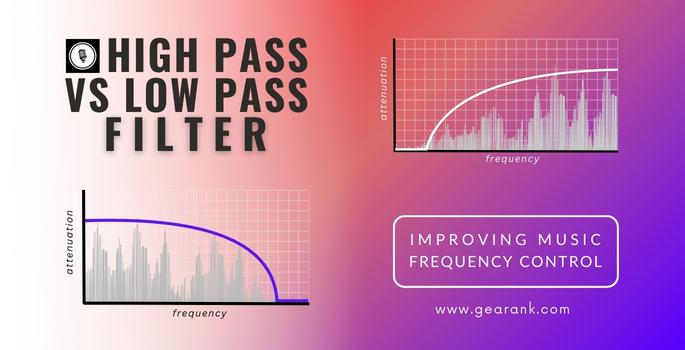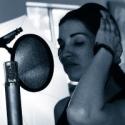High Pass vs Low Pass Filter Ultimate Guide

High Pass vs Low Pass FilterA low-pass filter allows the lower frequencies to pass through while attenuating the high frequencies. A high-pass filter does the opposite, letting higher frequencies pass through while reducing low frequencies. |
Audio pass filters, such as high-pass and low-pass filters, are tools that can attenuate the level of certain frequencies. However, what distinguishes a high pass vs low pass filter, and how are they utilized in music production for optimal results?
The main role of these two filters is to emphasize specific frequencies while suppressing others. In this article, I'll compare high-pass and low-pass filters. Explore their importance in different areas but most importantly in music production.
If you have experience using an EQ, you will find it easier to understand the functions of high-pass and low-pass filters. This guide will explain the differences between the filters and when to use them effectively. Keep reading for an explanation of HPF vs LPF.
What are Filters?
Filters are equalization tools that attenuate, boost, or pass frequencies. These filters cut, amplify, or allow frequencies through, depending on their set point.
In musical applications, these filters highlight specific frequencies in a track. For example, you'll need a low-pass filter to highlight the kick drum. You'll want to use a high-pass filter to get the bright tone of the cymbals.
There's also a bandpass and a band reject/notch filter. Usually, you'll see these filters represented in a graph, almost similar to what is EQ in music.
However, EQs and filters function differently. An EQ setting can raise or attenuate targeted frequencies of the track. Filters are fixed and will only affect the frequencies of a specific point.
A useful tool for mixing, mastering, or DJing. Filters make it easier to mix tracks as they allow frequencies to occupy a space and not interfere with others.
Passive and Active Filters
Passive filters utilize circuit resistors, capacitors, and inductors. They cannot amplify or boost the frequency signal but can suppress its harmonic currents and voltage distortion.
On the other hand, active filters can increase the gain of a passing signal. They use capacitors, resistors, and operational amplifiers (op-amps). Active filters perform the same function as passive filters but can also amplify or boost the signal that passes through them.
High Pass vs Low Pass Filter: What's the Difference?
As an audio engineer, these two will give you better control over the frequencies of the music. Using them, you can better sculpt your tracks to emphasize certain frequency ranges. This ensures that each track will have its own space within the mix.
-
What They Do: A high-pass filter (HPF) lets high frequency signals at a specific level pass through. It does this while attenuating the frequencies below that certain set level.
-
A high-pass filter attenuates the amplitude of the lower frequencies. For example, it highlights the brightness of an instrument or vocal track. It is mainly used to eliminate low frequency content, which, as a result, produce a cleaner, more focused sound.
-
Contrary to a high-pass filter, a typical low-pass filter (LPF) allows the passage of a signal lower than its operating frequency. Then, it cuts off frequencies in the higher range.
-
This filter is used to reduce the harshness or brightness of a track. A low-pass filter is commonly applied to vocals or any instrument to smoothen the top end and warm up the sound.
-
Filter Circuit Design: The circuit architecture of a high-pass filter consists of a capacitor in its input. A resistor then measures its output.
-
A low-pass filter circuit has it in reverse. Its input is a resistor, while it sends the signal to the output, which is a capacitor.
-
Operating Frequency: A high-pass filter operates higher than the cutoff frequency. Meanwhile, a low-pass filter does the opposite, operating lower than the cutoff frequency.
-
Usage or Application: The primary function of these two is to attenuate the frequencies above and below a set point. By doing this, you'll retain the frequencies you want to stand out while removing those you perceive to be unwanted.
I'll go into more detail about this topic in the following section.
When to Use These Filters?
Use High Pass Filters When...
Let's say you have a recording of some drum cymbals, but you notice that the kick drum is audible in the background. This can reduce the overall quality of your drum mix.
You use a high-pass filter to filter out the low-frequency signal of the kick. High-pass filters will keep the high-frequency cymbals audible in the mix. But, it will make the low-frequency kick inaudible.
Other Reasons for Using a High-Pass Filter
-
Utilize a low-pass filter to get rid of low audio frequencies below 2.0 kHz.
-
Lower frequencies, such as plosives or P-pops, result from pronouncing B, P, or Ts. Using a high-pass filter, you can eliminate these dips.
-
Environmental factors like wind, fans, air conditioning, or television can produce low-frequency noise. To get rid of them, a high-pass filter can smooth them out.
-
Use a high-pass filter to eliminate noise from holding a microphone that can compromise your audio quality.
-
Separate the lows and highs to ensure mix clarity and avoid instruments competing for the same frequency range. For example, send only high frequencies to the tweeters for clarity.
-
In RF laboratories, HPFs isolate low frequency signals in various test setups.
-
High-pass filters are used in harmonic measurements. It excludes fundamental signals from the source and permits only high-frequency harmonics.
-
HPFs are used in radio receivers and satellite technology to reduce low-frequency noise.
Use Low Pass Filters When...
For example, you recorded a kick drum but found the hi-hat cymbals bled into the mic. This high-frequency signal will make it challenging to mix the cymbal tracks accurately.
That's when a low-pass filter will come in handy. Insert it on the kick drum track and set the cut-off frequency output to 5–20 kHz (the general frequency range of a hi-hat). This will cut the high-frequency components while keeping the low frequencies of the kick drum audible.
Other Reasons for Using a High-Pass Filter
-
Use a low-pass filter to filter out high audio frequencies above 2.0 kHz.
-
Attenuating high-frequency components like sibilance in your audio, which comes from pronouncing Z, S, or T sounds. You can remove these peaks using a low-pass filter and make your audio less harsh.
-
With a low-pass filter, you can avoid high-frequency interference. This is commonly used in a communications circuit like a radio receiver.
-
Each speaker (tweeter, woofer, or subwoofer) in the audio device is designed to work within a specific frequency range. Filter out the high frequencies of about 2.5 kHz above and send low frequencies to the woofers. This will ensure the speaker's safety and improve the sound quality of the music.
-
In RF test laboratories, low-pass filters create complex test setups. They prevent high-frequency interference and make the tests more accurate.
-
Low-pass filters are also used in RF transceivers to improve the quality of low-frequency signals. This makes it easier to select the signals and get better sound quality.
How to Use an Audio Pass Filter When Mixing
On any digital audio workstation, add the filter as an effect to the desired track or channel via the mixer. If you have fully parametric EQ or graphic EQ effects plugins, these can also apply low-pass and high-pass filters to your audio signal.
Click and drag down the lowest or highest frequency band to cut the input signal to your desired frequency. Then, drag left or right to adjust the cutoff frequency.
Final Thoughts
The decision between using a high-pass vs low-pass filter largely depends on the specific application. While both filters hold equal importance, their use varies based on the situation.
By utilizing these filters, you can effectively highlight or eliminate specific frequencies. This will lead to a well-balanced mix as each track occupies its designated frequency range without interfering with other tracks.
A high pass and low pass filter will also ensure the safety of your speakers. By isolating specific frequency ranges, your speakers will only receive a signal that it's designed to handle.
Although these filters serve different purposes, they are both essential. They create an optimal space for your frequencies to shine through.
Frequently Asked Questions
What's the Difference Between Audio Pass Filters and EQ?
Audio pass filters, like high pass and low pass, affect a track by attenuating a target frequency range. Meanwhile, it lets other frequencies through.
An EQ can attenuate and boost multiple frequencies of a track simultaneously. This is especially useful for shaping and balancing the tone of a track.
What is a Band Pass Filter?
Band pass filters are a mixture of the two filters. It works to cut high-frequency and low-frequency bands from two cutoff frequency points. This leaves only the mid-range frequencies in between both cutoff frequencies.
What is the Audible Frequency Range?
The human ear can pick up sounds from 20 Hz to 20 kHz. However, this range reduces to around 15–17 kHz as we age.
Very low frequencies, like any sound below the 20 Hz range, are not audible but felt through vibration. This is why subwoofers are used. On the other hand, sounds above 20 kHz are too sharp and harsh for us to hear.
Contributors:
- Raphael Pulgar - Editor
- Jerry Borillo - Illustrator












